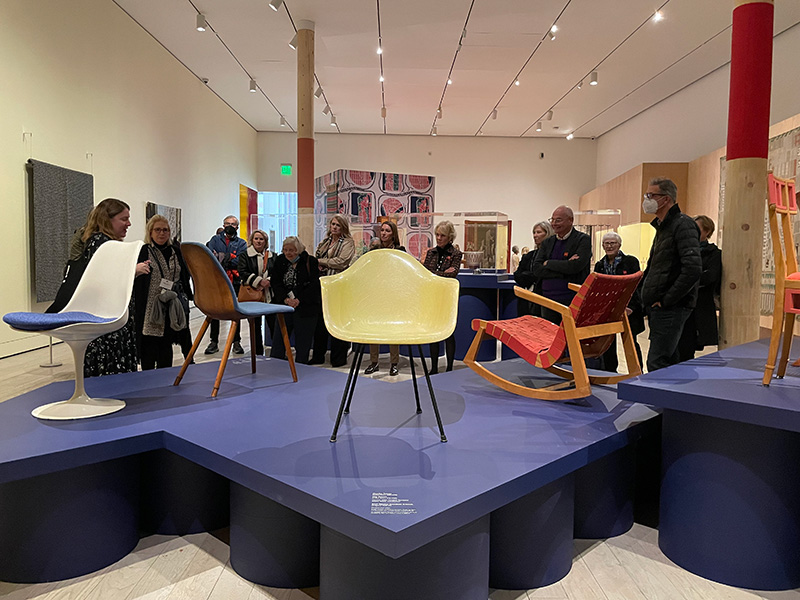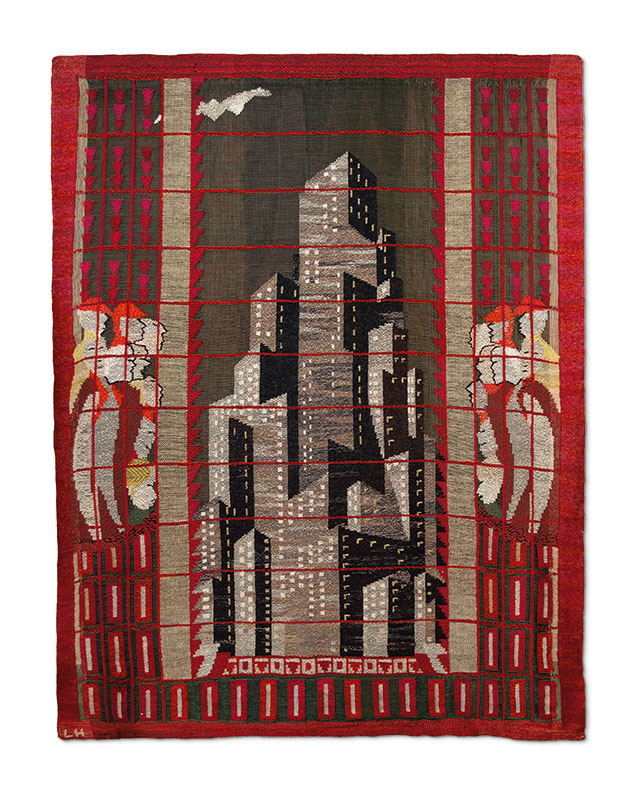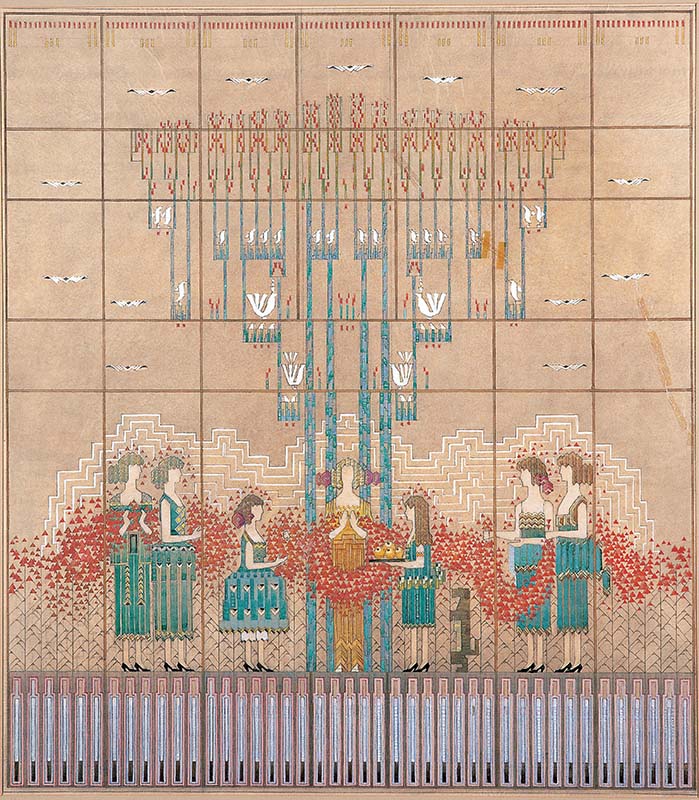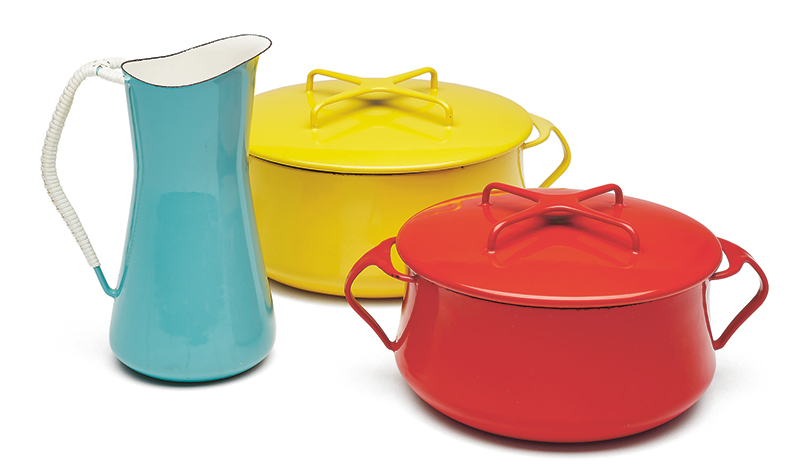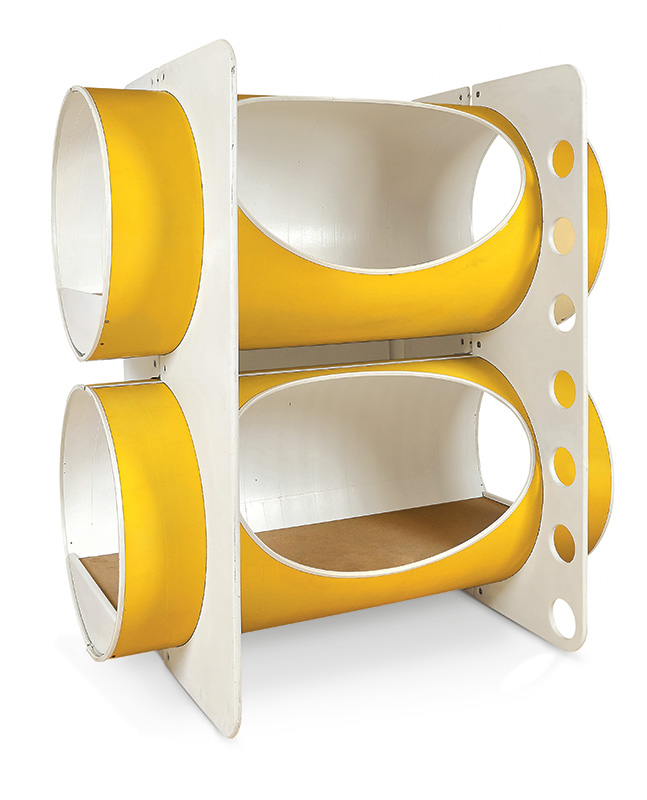Scandinavian Design and the United States: Cultural Exchanges From 1890–1980
by Monica Obniski and Bobbye Tigerman
Scandinavian design has become so intertwined into US culture over the years that it is difficult to determine where Scandinavian design ends and American design begins.
An extensive exhibition, Scandinavian Design and the United States, 1890–1980, is currently on view at the Los Angeles County Museum of Art (LACMA), which Decorative Arts Trust members had the privilege of enjoying during a special tour in early December (figure 1).
Scandinavian Design and the United States is an international collaboration between LACMA, the Milwaukee Art Museum, Nationalmuseum Sweden, Stockholm, and Nasjonalmuseet Norway, Oslo. The groundbreaking exhibition is the first to examine the considerable design exchanges between the United States and the Nordic countries of Denmark, Finland, Iceland, Norway, and Sweden during the 20th century. Serving as a corrective to the dominant narrative of central European émigrés (most associated with the Bauhaus) shaping modern American design culture, the exhibition presents a new international story.
The show features accounts of Scandinavian designers who immigrated to the United States, Americans who studied or worked in Nordic countries, the ambitious campaigns to market and export Scandinavian design to American consumers, and the American and Nordic figures who championed sustainable and accessible design practice.
Many of the issues considered in the exhibition remain relevant today, including the contributions of immigrants to their adopted societies, the importance of international exchange, critical analysis of cultural myths, and concern about environmental sustainability and accessibility. The exhibition proposes the idealized version of Scandinavian design—one of organic forms, natural materials, handicraft, etc.—is a construction. One example that challenges the myth is a chair designed by Dane Finn Juhl (and sold as such in the advertisements), but manufactured by Baker Furniture in Grand Rapids, MI, demonstrating an American-made “Scandinavian” design that emulated the purportedly handcrafted and refined quality of Scandinavian products.
Scandinavian Design and the United States showcases more than 175 captivating examples of furniture, industrial design, textiles, ceramics, glass, metalwork, jewelry, and lighting drawn from the co-organizing museums’ collections as well as from North American and Nordic museums and private holdings.
The exhibition is divided into six thematic sections: Migration and Heritage, Teachers and Students, Travel Abroad, Selling the Scandinavian Dream, Design for Diplomacy, and Design for Social Change.
Migration and Heritage explores how Scandinavian immigrants and their descendants made myriad contributions to the artistic and cultural life of their adopted communities. For example, Swedish-born artist Lillian Holm immigrated around 1930 to Detroit, where she worked as a weaver and influential teacher at several Michigan art schools. Her First Sight of New York hanging (figure 3) depicts her awe upon seeing the towering skyscrapers and dense crowds of the metropolis.
In Teachers and Students, we see how Scandinavian designers and craftspeople taught in American schools and ultimately shaped the course of American design. One center of influence was the Cranbrook Academy of Art in Bloomfield Hills, MI, for which Finnish architect Eliel Saarinen was hired to design both the physical campus and pedagogical structure. He envisioned its plan and major buildings. Working with his wife Loja, Eliel Saarinen’s The Festival of the May Queen Tapestry (figure 4) celebrates a revered rite of spring at Cranbrook. The elements of queen, court, pet, fauna and flora provide a charming and apt decoration for Eliel’s splendid dining hall in the original girls’ school at Cranbrook. (Read more about Loja Saarinen and Cranbrook in Nina Bloomfield’s article.)
Saarinen also hired leading Nordic artists as faculty, such as ceramist Maija Grotell, sculptor Carl Milles, and weaver Marianne Strengell. These leaders in turn attracted promising American students, including Charles and Ray Eames, Florence Knoll, Ed Rossbach, and Toshiko Takaezu.
The Travel Abroad section illustrates how cultural exchange between the Nordic countries and the United States was sustained through fellowships, formal academic programs, and apprenticeships. Howard Smith was an African American artist who moved to Finland to escape systemic racism and a lack of professional opportunities in his home country. Smith’s c. 1978 printed textile (figure 5) for the Finnish firm Vallila became popular as a home decoration and was exported back to the United States.
Selling the Scandinavian Dream examines how the image of Scandinavia was sold to American consumers by evoking the parallel mythic “American dream.” Both creations prompted the notion that consumer capitalism can lead to class mobility and a better quality of life. The marketing of Scandinavian design exploited a variety of stereotypes and myths about the Nordic region and Nordic people.
This theme is exemplified by the iconic colorful tablewares produced by the company Dansk (figure 6). For many Americans, Dansk’s enameled steel and carved teak products are quintessential examples of Scandinavian design. However, Dansk is an American company, founded in 1954 by a New York entrepreneur who worked with Danish designer Jens H. Quistgaard. Through strategic marketing and naming (Dansk translates to “Danish”), Dansk effectively capitalized on Americans’ admiration for Scandinavian design.
Design for Diplomacy considers how nations have long used design and architecture to advance their political goals through the “soft power” of cultural propaganda, national pavilions at world’s fairs, traveling museum exhibitions, and the construction of diplomatic architecture, such as embassies. Sometimes, their goals were overtly political: the Scandinavian countries sought to align themselves with the democratic, capitalist side of the Cold War divide by appealing to American tastes and associating their products with values of freedom, democracy, and openness. The greatest manifestation of international diplomacy in the post-World War II era was the United Nations headquarters (1946–52), built in New York City as a place for nations to gather peacefully. Denmark, Norway, and Sweden were invited to design the three largest meeting halls. Swedish artist Marianne Richter’s vibrant tapestry curtain (figure 7) provided the focal point for Sweden’s contribution, the Economic and Social Affairs Council Chamber. It enlivened the otherwise neutral-toned, modernist space, adding warmth to support the Council’s diplomatic and humanitarian mission.
In the final section, Design for Social Change, we see how the turbulent social and political conditions of the late 1960s prompted some designers to think critically about their work, envisioning a new role for design within society, and considering how design could address systemic problems, such as the planet’s dwindling resources, overconsumption and excessive waste, safety, and physical barriers to access. Swedish designers Maria Benktzon and Sven-Eric Juhlin created household products based on ergonomic research. Jim and Penny Hull founded H.U.D.D.L.E in California in the 1970s, creating lightweight and inexpensive furniture. They built Big Toobs beds (figure 8) by inserting tubular fiberboard into wooden panels, establishing a practical and fun sleeping environment.
American designer Niels Diffrient worked with a team in the design firm Henry Dreyfuss Associates to publish Humanscale (1974), an ergonomic design guide that accounted for a range of clients, including wheelchair users, rather than focusing on average proportions and able-bodied persons. Contemporary designers’ concern for solving endemic problems and addressing urgent global needs demonstrates the legacy of this design critique.
These are just a fraction of the remarkable objects that illustrate how Scandinavian design has had a lasting impact on American life, and how that cultural exchange crossed the Atlantic in both directions. The accompanying catalogue showcases the full range of stunning decorative arts gathered for this one-of-a-kind event. The exhibition will be at LACMA through February 5, 2023, and then will move to Milwaukee Art Museum from March 24 through July 23, 2023.
Monica Obniski is the Curator of Decorative Arts and Design at the High Museum of Art in Atlanta. She worked on this exhibition in her role as Demmer Curator of 20th- and 21st-Century Design at the Milwaukee Art Museum.
Bobbye Tigerman is the Marilyn B. and Calvin B. Gross Curator, Decorative Arts and Design, at the Los Angeles County Museum of Art.
A print version of this article was published in The Magazine of the Decorative Arts Trust, one of our most popular member benefits. Join today!

